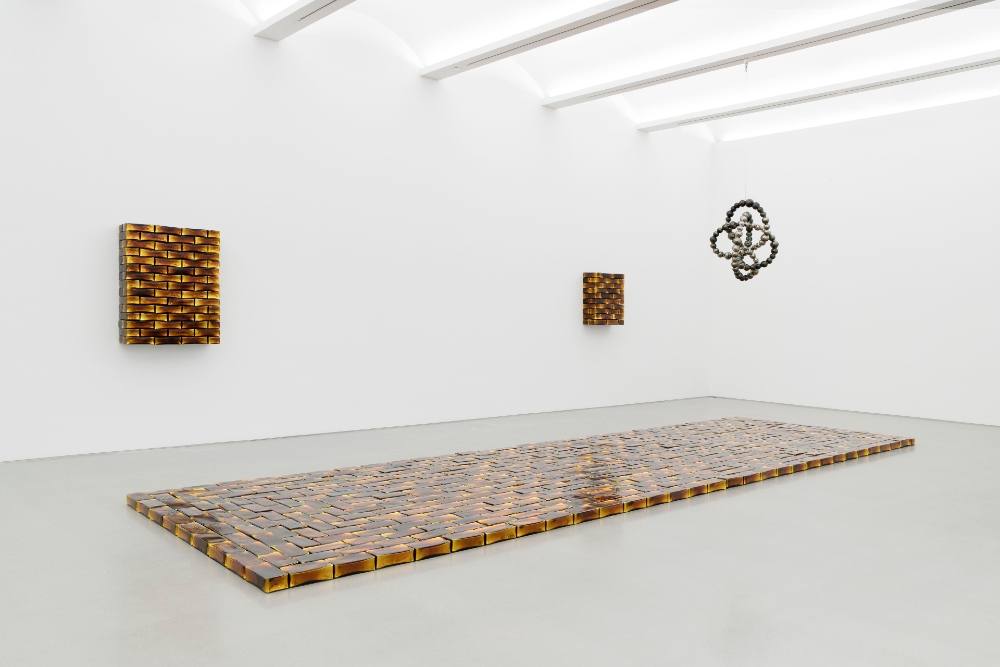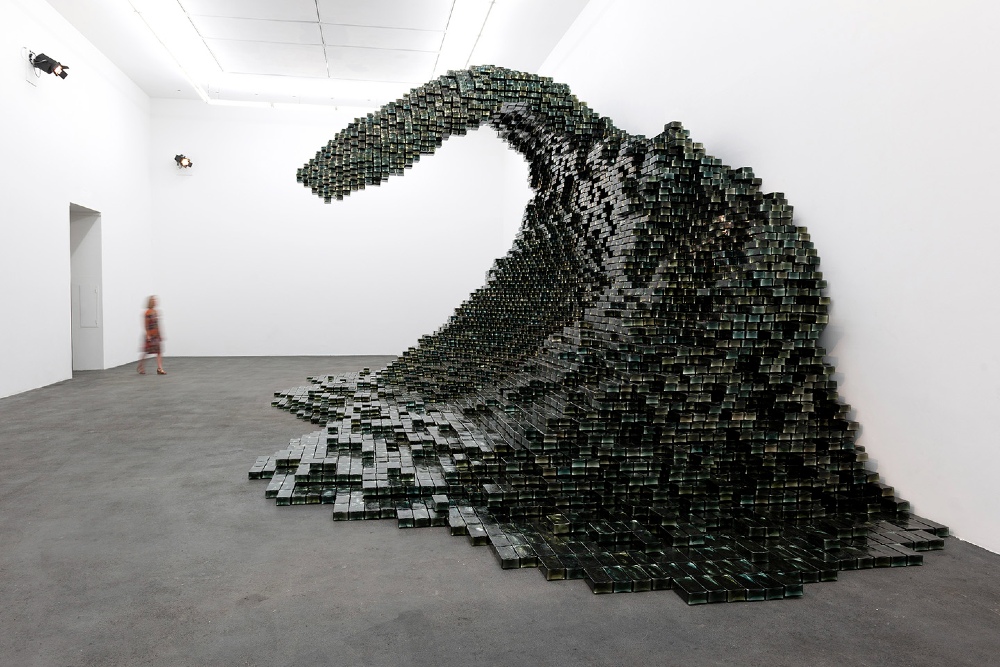A giant pearl necklace hung in the stairwell leads up to the “tornado room.” This is where Jean-Michel Othoniel has chosen to hang his “mobiles,” on the third floor of the gallery – a former textile factory in Manhattan’s Lower East Side. The sparkling pearls have been one of the French artist’s trademarks since the 1990s, and seem to take flight in a whirlwind of shimmering light. The same emotion is palpable in his Les Belles Danses fountain, installed in the gardens of the Château de Versailles in 2015.

“My work is presented as if thrown into space, but it is actually highly complex,” says Othoniel. “I have worked extensively with engineers and mathematicians to achieve this impression of weightlessness.” The metallic sphere comprising each pearl was hammered into shape by Parisian brass artisans before being threaded onto a structure made with stainless steel and aluminum, and they now all float beneath the glass roof.
The same tranquility reigns on the ground floor, where an expanse of glass bricks covers the gallery floor. The bricks of blown glass first appeared in the artist’s repertoire in 2012 for an exhibition at the Brooklyn Museum. Today, they hold center stage among his work, presented as both sculptures and monuments. “Bricks are my new pearls,” says Othoniel.
France-Amérique: Your work is exhibited in New York, but also in a restaurant in Dallas and in San Francisco’s Golden Gate Park. Can you describe your relationship to the United States?
Jean-Michel Othoniel: I have lived in New York and Miami. I have also taught at the University of Hawaii and at Tulane University in New Orleans. I love the United States and its diversity. Contemporary art is part of the culture of this country. The same can’t be said for Europe, where contemporary art is always pitted against the traditional arts. The United States was founded on the concept of renewal, and there is a far starker relationship with contemporary art here. People are more curious about artists, and there is more support, more structures in place, and more available financing.
How did this country influence your work?
While Asia influenced my spirituality, the United States awoke my political and social conscience. My Precious Stonewall series exhibited on the gallery’s ground floor is a poetic reference to the Stonewall riots [which accompanied the birth of gay militancy in New York in 1969]. In their capacity as altars hung on the wall or placed on the ground, these ensembles of yellow glass bricks are a nod to the yellow brick road leading to the Wizard of Oz’s castle. This image is part of the culture of Stonewall. Some say the riots were sparked by the death of Judy Garland [the actress and LGBTQ icon who starred in the 1939 movie]. The yellow brick road leads to a magical land, but also to a revolution.


You have installed a “blue brick road” next to the yellow bricks. Where does it lead?
It’s a work of pure invention! Perhaps it leads down the path of architecture? After using wax, sulfur, and pearls, I started focusing on bricks. Precious Stonewall and Grotta Azzurra were the first step. I now hope to spread bricks across a whole room, or even an entire building. I have been working with glass artisans in Firozabad, in India, since 2012. The legend surrounding the Tower of Babel inspired my work. When the tower collapsed, what happened to all those bricks? How can we rebuild a utopia using these bricks? And from a practical point of view, I asked myself how I could integrate glass bricks – such fragile constituent parts – into a large-scale work.
Is developing the dialogue between art and architecture also the objective of the panel discussion you have organized alongside your exhibition?
I want to make the exhibition space into a place of dialogue. There is a certain solitude in being an artist today. There was more discussion when I started 30 years ago, but smartphones and social media have now isolated us. By organizing a roundtable discussion, I am also hoping to hold my ideas up against those of architects, art critics, researchers, and students. I appreciated the mutual respect and admiration among the artists – whether writers, poets, musicians, or composers – while I was at a residency at the Villa Medici.

Is your installation La Grande Vague, unveiled in the South of France in 2017, part of this architectural ambition?
It is part of it, yes. I will be installing an even bigger version at the museum of modern and contemporary art in Saint-Etienne this summer. The whole structure will be 50 feet long and 20 feet high. A 10,000-brick monster! I self-produced this 55,000-pound work, but it is so heavy and complicated – the assembly alone takes a month – that it is very difficult to fit it into the logic of a museum or a gallery. And that pushed me to wonder: What is the destination of art?
Jean-Michel Othoniel: Dark Matters, from March 3 through April 15 at Perrotin Gallery in New York.












